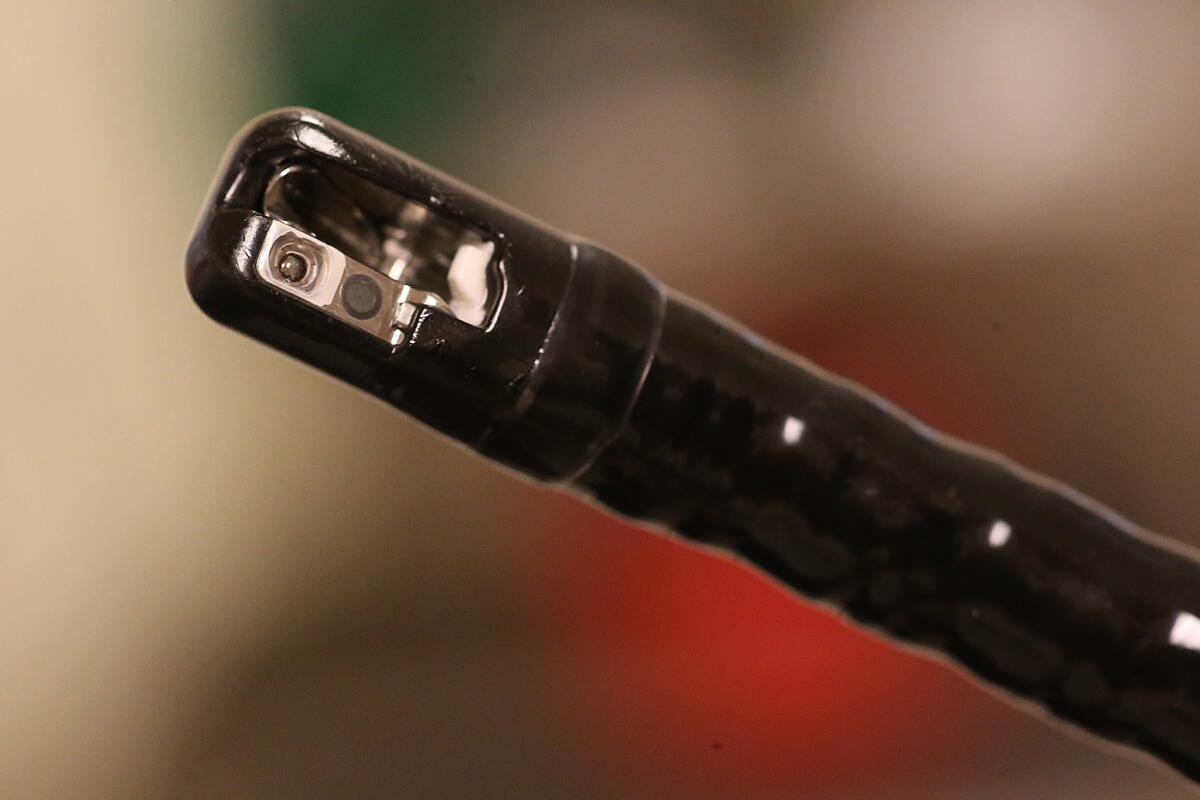Cheaper, cleaner and safer? Hospitals turn to disposable scopes to fight superbug infections

In response to a series of superbug outbreaks around the country, some doctors and hospitals are trying out disposable scopes to combat the spread of antibiotic-resistant bacteria.
U.S. regulators recently approved two new colonoscopes designed to be used just once and thrown away. They will sell for $250 or less apiece — compared with about $40,000 or more for a conventional scope that can be disinfected and used again and again for several years. Other companies are promoting similar devices for use in the lungs and kidneys.
The new scopes are coming primarily from smaller companies looking to challenge a handful of dominant makers of the flexible, lighted tubes that doctors use to peer deep inside patients. The new players in the market are seizing on growing evidence that many reusable instruments cannot be cleaned reliably, even when manufacturer’s instructions are followed.
“If you can tell patients we have a disposable device so there’s really no chance of infection, that has to be very appealing,” said Chris Lavanchy, engineering director at the ECRI Institute, a nonprofit organization that tests medical devices. “This could allay public fears.”
Scopes include a wide array of devices used on millions of patients annually. As they snake through a patient’s throat, intestines and other cavities, they pick up mucus, blood and thousands of microbes. But the delicate devices cannot be sterilized like a scalpel because intense heat would destroy crucial components.
Instead, the scopes are brushed, washed with disinfectants, rinsed and dried in preparation for the next patient. Despite those efforts, contamination can persist, and the emergence of drug-resistant bacteria can make patient infections difficult or impossible to treat.
The threat has led to safety alerts from the Food and Drug Administration and a recent U.S. Senate investigation into repeated failures by manufacturers and hospitals to report outbreaks. The Times first reported about scope-related outbreaks at UCLA’s Ronald Reagan Medical Center, Cedars-Sinai Medical Center and Pasadena’s Huntington Hospital.
Overall, as many as 350 patients at 41 medical facilities worldwide were exposed to or infected by contaminated gastrointestinal scopes from 2010 to 2015, according to the FDA. And at least 35 patients at U.S. hospitals have died since 2013 after developing infections tied to tainted scopes, according to hospitals and public health officials.
For now, just a handful of medical centers are experimenting with the disposable colonoscopes. Some doctors remain skeptical about whether a cheaper scope will provide the high-quality images and versatility they need to diagnose illnesses and treat patients effectively.
Many doctors count on the sophisticated cameras on existing scopes as well as multiple channels inside the device to accommodate surgical instruments.
Simon Lo, a nationally known gastroenterologist at Cedars-Sinai in Los Angeles, said he shares those concerns. Nonetheless, he said he’s eager to try the disposable colonoscope from German device maker Invendo Medical in the coming months. The scope secured clearance from the FDA in August.
“I’m not totally sold this will be comparable to the [conventional] scopes other companies have spent decades perfecting. It’s almost too good to be true with it being so cheap,” Lo said. “But this is a fantastic possibility and at least gives us an alternative to the current scopes.”
Physician groups such as the American Society for Gastrointestinal Endoscopy maintain that the overall risk of infection from the traditional devices is very low. They say the benefits of screenings and many other procedures far outweigh any potential danger.
Some doctors say a simpler, single-use scope could be sufficient for many routine examinations. It also could be preferred for immunosuppressed patients who are more susceptible to infection and for patients who have already tested positive for antibiotic-resistant bacteria and would be likely to spread it.
“For those patients, it would be great to use this and throw it away,” Lo said.
Cedars-Sinai reported four infections last year from contaminated duodenoscopes, which are inserted down a patient’s throat and used to treat problems in the digestive tract such as cancers and blockages in the bile duct.
Colonoscopes, which peer at the inner lining of the large intestine, have not been linked to the recent outbreaks, but concerns about cleaning and the spread of bacteria apply to all types of reusable scopes. Last year, the FDA warned about the risk to patients posed by bronchoscopes, used to examine problems in the airway and lungs. In one recent study, researchers found that more than 75% of colonoscopes and gastroscopes were still contaminated after cleaning and disinfection in accordance with the guidelines.
Hospitals have experimented with a wide variety of new safety measures over the last two years. Some facilities started testing scopes for contamination after cleaning and then holding them in quarantine for 48 hours to check them again for bacterial growth.
Those steps added layers to what was already a labor-intensive process. It costs an estimated $75 or more to clean a scope each time.
“There is a lot of time and money tied up in that,” said John Cifarelli, chief commercial officer for Invendo. “The best solution is a device that doesn’t have to be cleaned.”
The leading scope makers haven’t shown much interest thus far in single-use devices, which could affect their long-standing dominance in the business.
Olympus, which controls 85% of the U.S. market for gastrointestinal scopes, did not respond to a request for comment. The Tokyo-based company, linked to numerous infections in the United States and Europe, conducted a voluntary recall of its duodenoscopes this year and made repairs designed to reduce the contamination risk.
In a statement, another big manufacturer, Fujifilm, said it “has no plans at this time to market single-use disposable scopes, and cannot speak to the benefits or risks associated with such products.”
Israeli company GI-View received FDA clearance in August for its single-use colonoscope, called Aer-O-Scope, priced at about $200. The company’s chief executive, Tal Simchony, acknowledges that his smaller company faces an uphill battle against the industry giants. But he said he’s optimistic it can address the “ick” factor some patients feel with a reusable scope.
Other companies see opportunity too. Boston Scientific, a bigger device maker, promotes a disposable ureteroscope for kidney stones and other uses. Ambu, based in Denmark, has sold a single-use bronchoscope for about $300 in the United States for the last few years.
Chad Terhune is a senior correspondent with California Healthline, a service of the California Health Care Foundation published by Kaiser Health News.
ALSO
David Lazarus: Soaring insulin prices highlight futility of ‘free market’ for meds
CalPERS widens its ban on tobacco-related investments
If you have employer-provided health insurance, an Obamacare repeal would affect you too
More to Read
Inside the business of entertainment
The Wide Shot brings you news, analysis and insights on everything from streaming wars to production — and what it all means for the future.
You may occasionally receive promotional content from the Los Angeles Times.











